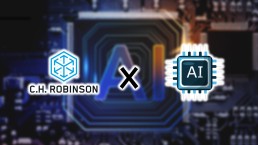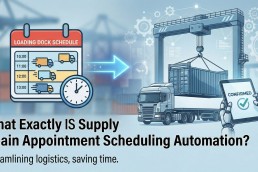How C.H. Robinson’s Approach to AI Is Shaping The Future of Logistics

In an era of volatile freight markets, squeezed margins, and relentless pressure to perform, logistics providers must look internally toward operational optimization. C.H. Robinson is doing exactly that by transforming its operations with a disciplined, scalable AI-driven model. As a fleet or service provider, there are strategic takeaways worth noting. During the same time Forbes publishes an article citing 95% of AI Implementations have failed, C.H. Robinson is proclaiming successful implementation and deployment of AI solutions across their operations. So, it’s probably worth asking ourselves, what did they get right? What lessons can we take away from their years of focus on the topic?
Planning for the Future: Continuous Operational Improvement
According to C.H. Robinson, it’s not about simply preserving what you have; it’s about continuous improvement. Their blog outlines how their operating model is “built for progress” rather than preservation. C.H. Robinson. With that mindset, they’ve embedded what they call “Lean AI” into their quote-to-cash lifecycle: more than 30 AI-agents have already been deployed, reducing manual touches, increasing productivity, and enhancing cost efficiency. C.H. Robinson+1
For fleets and service operations, this suggests that the path forward cannot be focused only on revenue growth; it has to include investing in smarter operations, smarter service, and smarter automation.
Agentic Supply Chain: Intelligence That Learns, Decides, and Acts
C.H. Robinson recently launched what it calls the Agentic Supply Chain, a step beyond automation into AI agents that “perceive context, make decisions in real time and self-optimize global supply chains at scale.” C.H. Robinson.
Some specific examples of how they are utilizing their agents:
- AI agents that process quoting and pricing in seconds, using real-time market data, Produce Wire
- Order-booking agents that decide between truckload vs. LTL based on context, commodity, and cost. Produce Wire
- Freight-classification agents that perform in seconds what used to take humans many minutes, solving for the new LTL classification regime. Supply Chain Digital
- Agents that monitor available trucks, post capacity to their real-time center, and match freight with carriers faster than ever. Produce Wire
The companies leading the industry are embedding intelligence into workflows that used to be high-manual and high-cost. They are already years into development and testing, and as pioneers in the logistics/AI space, we should be paying close attention to the areas where they find success. What takes enterprises the size of CHR years can take smaller enterprises mere months to implement.
The Results: Productivity, Margins, and Impact
C.H. Robinson’s data bear this out. In their “Lean AI” blog, they cite productivity improvements of more than 35 % since embedding their AI agents, along with cost-efficiency gains and improved operating leverage. C.H. Robinson. Similarly, they report that these AI agents handle millions of tasks across their shipment portfolio, quoting, ordering, classification, tracking, the kind of volume and scale many smaller operations might dream of. C.H. Robinson+1 For fleet operators and brokers, it is worth noting that the competitive edge is increasingly operational intelligence and capability, not just the scale of your fleet or network.
Your Takeaways
Here are a few strategic implications:
- Operational repeatability matters – The tasks you do every day (booking, routing, tracking, compliance) matter. Embedding even modest automation can reduce cost, error risk, and latency.
- Data isn’t just for BI dashboards; it needs to be used in real time – C.H. Robinson’s agents use real-time market/context data, not just historical dashboards. For fleets, this means rethinking data architecture toward “actionable now.”
- Automation + human expertise = the hybrid model – C.H. Robinson’s framing is that AI works alongside people, empowering them rather than replacing them. Your driver teams, dispatcher teams, and ops teams still matter; they just need better tools and better processes around them.
- Scalability isn’t optional – the idea of “what if you doubled in size” should be baked in. C.H. Robinson designed its AI model to scale across tens of millions of shipments; you should design your processes to scale across tens of thousands of moves.
- Investment decisions matter more than assets alone – While fleets often focus on tractors, trailers, drivers, and capacity, the future will reward those who invest in systems, workflows, and technologies that make those assets work smarter.
Starting Now: What Can You Do?
- Audit which manual tasks in your current operation are highest-volume and highest-frequency, these are the “low hanging fruit” for automation.
- Assess your data architecture: Where is your operational data? Where is it siloed? What’s the path to harnessing it for actionable outcomes (e.g., carrier matching, appointment scheduling, status updates)?
- Pilot automation with one business unit (a region, a customer vertical, a dispatch group) and measure productivity, error-rate and carrier/shipper satisfaction. Then scale.
- Build alignment across your operations, finance, tech and service teams—that’s how C.H. Robinson frames its “Lean AI” model: disciplined, cross-functional, continuously improving.
- Use this Forbes article as a resource. Learn from the mistakes of others to ensure your AI and automation efforts are not a flop. Forbes


